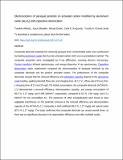| dc.description.abstract | Composite electrode materials for removing paraquat from contaminated water were synthesized by loading aluminium oxide (Al2O3) onto activated carbon (AC) via co-precipitation method. The composite properties were investigated by X-ray diffraction, scanning electron microscopy, Fourier transform infrared spectroscopy, and energy-dispersive X-ray spectroscopy. Capacitive deionization batch experiments compared the electrosorption of paraquat herbicide by the composite electrode and the pristine activated carbon. The performance of the composite electrodes showed that the removal efficiency and adsorption capacity depend on the aluminium oxide loading, applied potential, flow rate, and charging time. At 1.2 V, a flow rate of 15 mL/min, a charging time of 3 h and 20 mg/L PQ initial concentration, the composite electrode (AC/Al2O3-1:1) demonstrated a removal efficiency, electrosorption capacity, and energy consumption of 95.5 %, 1.27 mg/g, and 0.055 kWh/m3, respectively, compared to 62 %, 0.83 mg/g, and 0.11 kWh/m3 for the unmodified AC. The presences of other ions/pollutants were found to have negligible interference on PQ pesticide removal as the removal efficiency and electrosorption capacity of the AC/Al2O3-1:1 composite in both artificial (95.5 %, 1.27 mg/g) and natural water (87.5 % 1.17 mg/g). The study confirmed that composite electrode can reused several times, as there was no significant decrease in its regeneration efficiency even after multiple cycles. | en_US |

